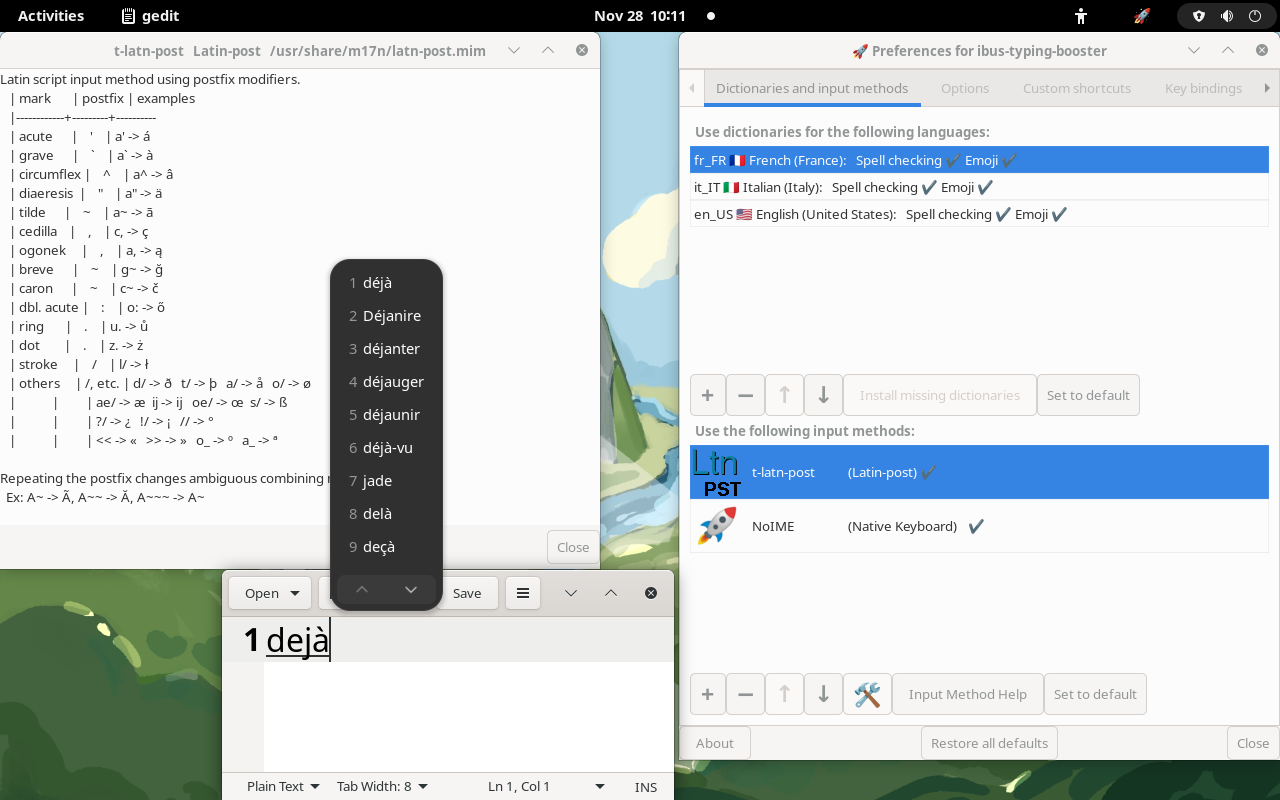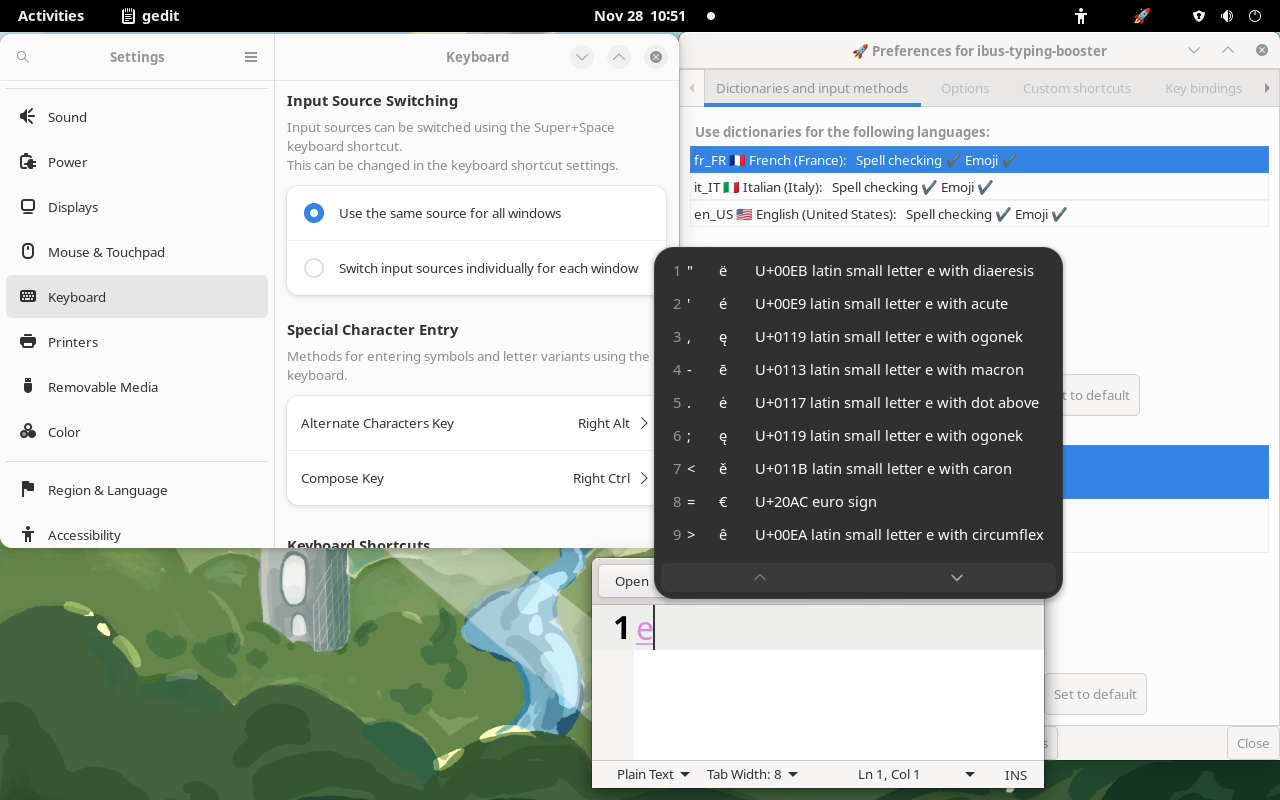New issue
Have a question about this project? Sign up for a free GitHub account to open an issue and contact its maintainers and the community.
By clicking “Sign up for GitHub”, you agree to our terms of service and privacy statement. We’ll occasionally send you account related emails.
Already on GitHub? Sign in to your account
IBus input method to quickly find equivalent locale character for a given ASCII character #2461
Comments
Actually implementing this idea is not impossible on desktops, for example MacOS has this, see: https://macpaw.com/how-to/type-accents-on-mac I have this idea on my todo list for ibus-typing-booster. But it is quite difficult on Xorg or Wayland to detect whether a long press has happened and I had no time yet to investigate how that might be possible. |
Even though ibus-typing-booster cannot do the longpress thing yet, it might still be very useful for you to write non ASCII characterss in Italian, German, and French. I am using an US keyboard layout as well, my native language is German and I am learning Italian and French. I am typing the accented letters usually with ibus-typing-booster. For ibus-typing-booster, see: https://mike-fabian.github.io/ibus-typing-booster/ User documentation: https://mike-fabian.github.io/ibus-typing-booster/docs/user/ |
|
This screenshots shows one way how one can input accented characters using ibus-typing-booster: In this screenshot, one can see that I have added English, French, and Italian dictioaries in the ibus-typing-booster setup. Also, I have added the Then I clicked the For example, if I want type the French word déjà I can type an U+0027 APOSTROPHE after the e to get é and a U+0060 GRAVE ACCENT after the a to get à. You can also see in the screenshot that I didn’t actually type déjà but dejà, i.e. I “forgot” the accent on the That means if you type French words, you don’t have to type the accents directly, you can usually type the words without the accents and then select the correct spelling with accents from the candidates shown. |
|
Another way to type accents is to use For details about what Compose is and how it works see: https://mike-fabian.github.io/ibus-typing-booster/docs/user/#5 In this screenshot you can see that I did use the Gnome Control Center Then (with ibus-typing-booster active, i.e. selected in the Gnome panel) I typed
The It starts with i.e. it shows me that I could finish the sequence by typing an Or I could select the candidates shown by typing the number in front of the candidate, i..e type a |
I have read the article and that looks really cool, however I have no idea how someone would go around implementing such a feature. At first I thought that libinput could be able to handle the detection but you would have to implement some sort of timer or timeout and that's too high level for libinput so I guess it could be up to each compositor to implement such a feature. It probably won't happen because using the compose key along with tab to see each suggestion is a simpler approach. |
Yeah I just tried it and that works pretty well with french and german words, it had some difficulties when dealing with some short italian words (sì, papà, sé, lì, né, tè, là) but after writing a bit it adjusted itself pretty quickly and now typing-booster gives those suggestions without any problems. This probably happens because I am using three dictionaries simultaneously (I always switch the highest priority dictionary to match the language I am using, so maybe this happens only because those words are kind of an edge case). |
This works well, the dictionary suggestions help a lot but using the compose key is useful when those suggestions are not good enough. Anyway this looks really good and I thank you for your time, you've been incredibly helpful :) |
|
I improved the display of the compose completions in horizontal lookup tables, see the screenshot and video at mike-fabian/ibus-typing-booster#407 That improvement is included in: Included in https://github.com/mike-fabian/ibus-typing-booster/releases/tag/2.19.10 |
|
@fSidel Anything left to do here? Or can we close this? (Accented characters on long press like on MaOS are an interesting idea for the future, maybe, if I have time I will look into that, it is already on my ToDo listr, but probably not soon) |
|
@mike-fabian Sorry, I have kept you waiting. Yeah we can close this, I just tried the last release and the horizontal layout is fine. Thank you. |



I have a laptop keyboard with an ANSI layout, however since I live in Europe I often need to write text with non ASCII characters for languages like italian, german and french.
This feature request has been inspired by two different pieces of software:
As you probably know (1) offers long presses on ASCII characters to write related locale characters, such an implementation is not possible on a desktop environment for obvious reasons, however it may be a good reference for mapping ASCII characters to their non-ASCII siblings.
A more practical approach for desktops and laptops is (2), the Quickchar app is really similar to the IBus service integration offered in GNOME for input of japanese, chinese and korean characters on an ANSI keyboard. See this screenshot for reference:

In the Budgie Desktop Environment the app is triggered by a keyboard shortcut which calls a UI on screen that allows a user to write an ASCII character and returns a list of related locale characters that can be written in the text input field by pressing a number or by tabbing to navigate the list of characters and pressing enter on the chosen character.
As you can see this feature is almost identical to the one offered by IBus on GNOME, however as far as I can tell IBus only offers these capabilities for non european characters. As an example, in the following screenshot:

The ideal output for the "e" character could be: "ê è é ë ė ę ē"
I thank you for your time and for all the work you have put to build ibus! I am a junior developer myself so I'd be glad to contribute in any way to implement this feature request, even though I am not really familiar with the architecture of ibus.
The text was updated successfully, but these errors were encountered: